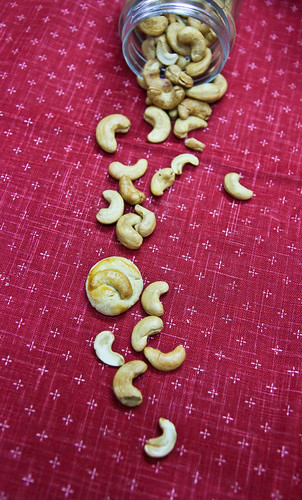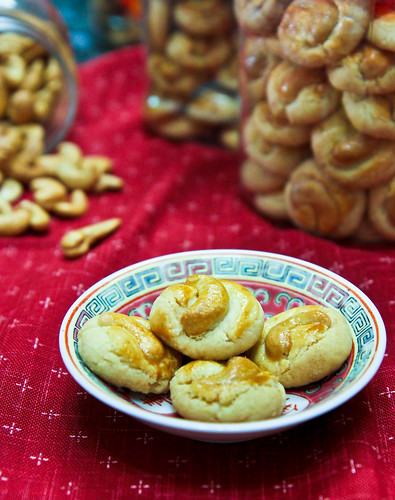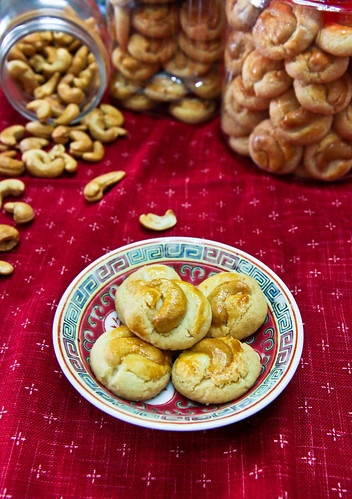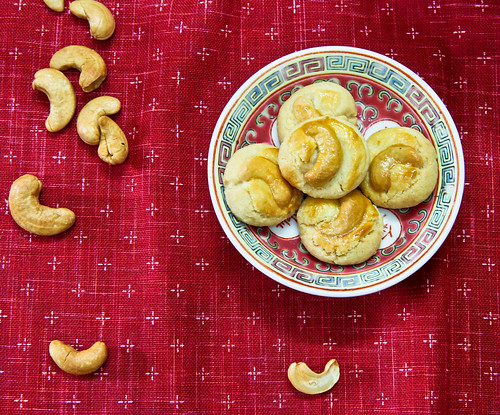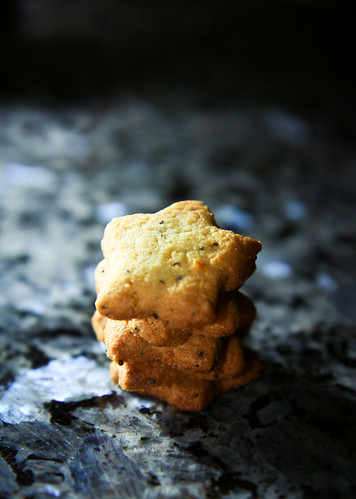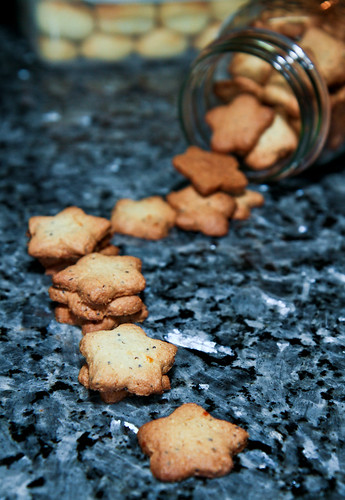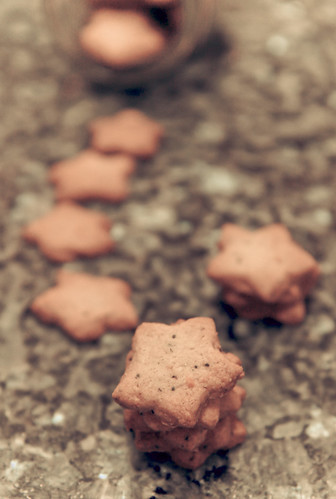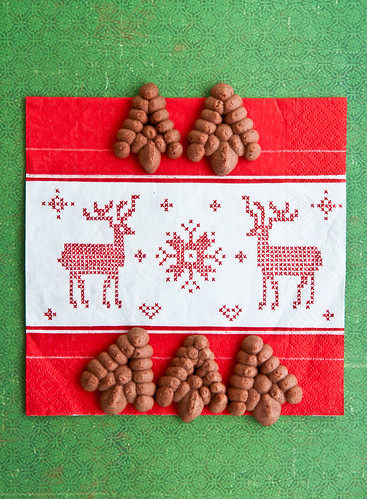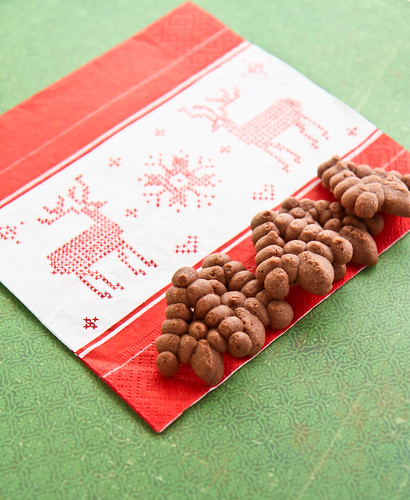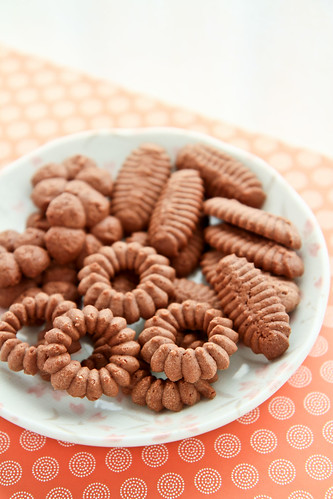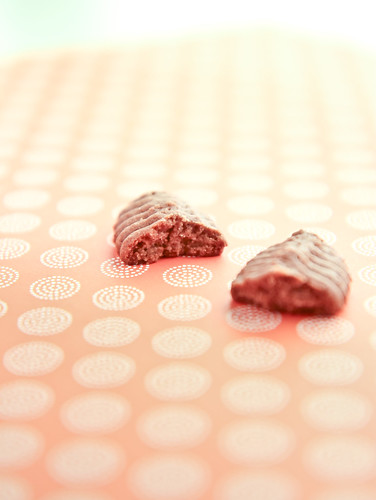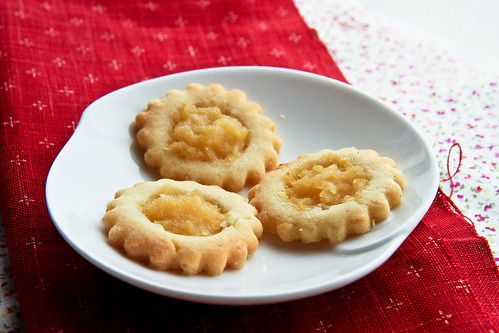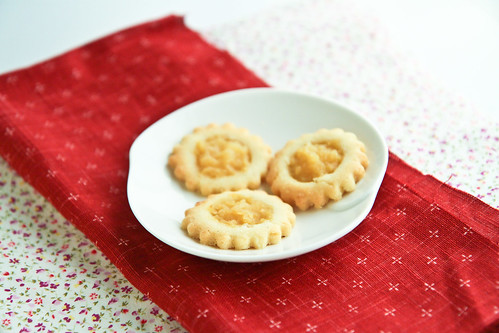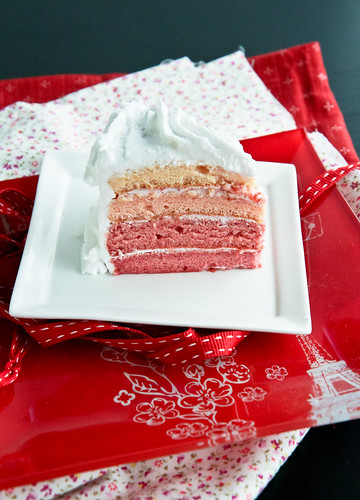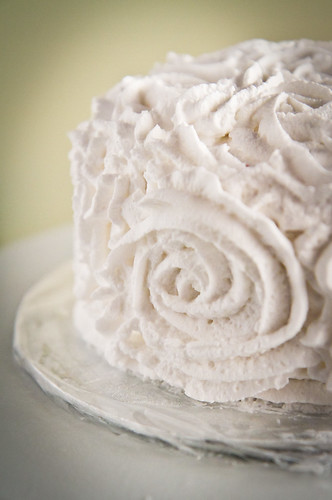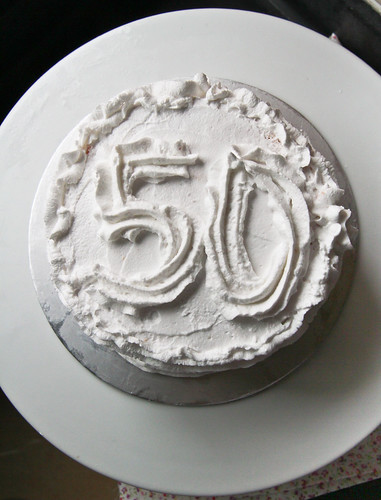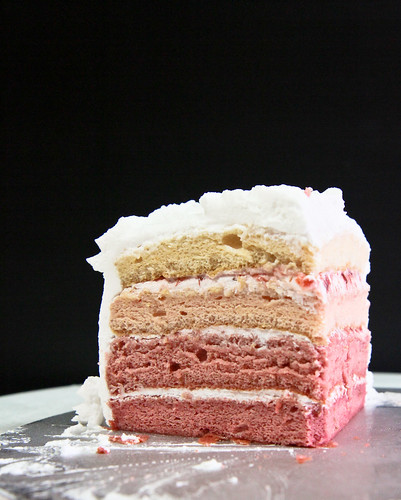If you check in every Singaporean or Malaysian mother’s recipe book for Chinese New Year cookies, I bet you'll find a recipe for cashew nut cookies. These cookies are ubiquitous during Chinese New Year and I’ve never had one go past without seeing and eating these cookies. It is also mainly during this period that my mom fries up kilograms of cashew nut cookies and packs them into glass jars for relatives to snack on. Why so? Well, knowing how superstitious Chinese people are, we have associated symbolisms and meanings even to food we eat. I mean, the entire process of lo hei (捞起) yu sheng or yu sang (鱼生) is filled with symbolism - check out this website for the 'prosperous words' to say when you're in the process of making the prosperity salad and tossing it.
As for cashew nuts (腰果), we Chinese believe that the nuts resemble gold ingots from days long gone, and so we eat them in a bid to get wealthy. Ironic much? In any case, you can choose to roast the cashews by placing them on a tray in a preheated oven, but from experience, these are not as nice as compared to fried ones. All you need to do is to use some oil (olive oil is good) and continually toss and 'fry' the cashews. They turn a lovely golden brown (as you can see above), and taste better. And because you're making this snack yourself, you can choose NOT to salt them. And they are cheaper if you buy them raw and fry/roast them yourself rather than buy them packaged and salted, ew. The healthier option of course is to roast them in the oven, but I justify it by eating less of these nuts. Another good thing about these cashews is that they have a lower fat content than most other nuts and more than three-quarters of their fat is unsaturated fatty acids. They contain high quantities of oleic acid, which is the same fat which promotes good heart health. But as with any foods, eat in moderation! About 20 cashews (35g) count as one serving, and as with most nuts, do not eat more than one serving a day. It's best to eat less than 3 servings per week. Most importantly, cashew nuts are rich in minerals, such as zinc (important for growth and development) and copper (important for your joints and antioxidant defenses) among others. I learnt this recently, and I've been encouraging my mom to eat more cashews because she suffers from low blood pressure and has a weak constitution, so iron and minerals in any natural form is most welcome!
This year however, I had to do some modifications. As usual, I only decided to bake this very last minute (ie, on the eve of New Year’s eve), so I didn’t have all the ingredients I needed. I didn't have the shortening and self-raising flour that was required, so I replaced it with margarine and normal flour with baking powder instead. So here is 2012's modified recipe:
Cashewnut Cookies
Anyway, today's the ninth day of Chinese New Year, and it's the day that Hokkiens pray to the Jade Emperor (or 天公). There are varying stories of why this is so grandly celebrated by the Hokkiens, but the common thread is that the Hokkien people were forced to hide in sugarcane plantations by their enemies during the Chinese New Year, and when it was finally safe, it was the 9th day of Chinese New Year already. So these Hokkiens went back to their homes and celebrated this 9th day as if it were the 1st day, hence the grand celebrations and the act of giving thanks. Not sure how true this story is, but at least it explains the grand feasts that some have on this day (roast pig, et al).
I don't exactly celebrate Chinese New Year besides the first and second day, because that's all the holiday I get from the Singapore government, so these cashew nut cookies reminiscent of gold ingots are all that I'll be offering to 天公 for now :]
And yes, I took these photos the same time as I did the gluten-free orange poppy seed cookies the previous post, and was still experimenting with indoor flash. I'm still not too pleased with the photos but I was in a rush as usual, so I can only grumble and learn from my mistakes now, after post-processing.
As for cashew nuts (腰果), we Chinese believe that the nuts resemble gold ingots from days long gone, and so we eat them in a bid to get wealthy. Ironic much? In any case, you can choose to roast the cashews by placing them on a tray in a preheated oven, but from experience, these are not as nice as compared to fried ones. All you need to do is to use some oil (olive oil is good) and continually toss and 'fry' the cashews. They turn a lovely golden brown (as you can see above), and taste better. And because you're making this snack yourself, you can choose NOT to salt them. And they are cheaper if you buy them raw and fry/roast them yourself rather than buy them packaged and salted, ew. The healthier option of course is to roast them in the oven, but I justify it by eating less of these nuts. Another good thing about these cashews is that they have a lower fat content than most other nuts and more than three-quarters of their fat is unsaturated fatty acids. They contain high quantities of oleic acid, which is the same fat which promotes good heart health. But as with any foods, eat in moderation! About 20 cashews (35g) count as one serving, and as with most nuts, do not eat more than one serving a day. It's best to eat less than 3 servings per week. Most importantly, cashew nuts are rich in minerals, such as zinc (important for growth and development) and copper (important for your joints and antioxidant defenses) among others. I learnt this recently, and I've been encouraging my mom to eat more cashews because she suffers from low blood pressure and has a weak constitution, so iron and minerals in any natural form is most welcome!
So as I was saying previously, oldies are goodies, and these are my mom's super good cashew nut cookies recipe. I'm not sure where the original was from, but I'm pretty sure both the ingredients and instructions have been modified enough over the decades for my mom to call it her own. I find it rather astonishing (and amusing) at how similar my mom and I are in terms of recipe jotting – my mom crams a few recipes on a page, which I do now without knowing she did the same, and she writes comments such as “very good” on the side of recipes she tries, which I do as well.
If you recall, I also baked this last year, but I used the original recipe and didn't post the recipe up. So here it is:
120g butter
120g shortening
125g sugar
1 tsp vanilla
1 tsp salt
1 cup ground cashew nuts
155g self-raising flour
125g plain flour
Some cashewnuts for decoration
This year however, I had to do some modifications. As usual, I only decided to bake this very last minute (ie, on the eve of New Year’s eve), so I didn’t have all the ingredients I needed. I didn't have the shortening and self-raising flour that was required, so I replaced it with margarine and normal flour with baking powder instead. So here is 2012's modified recipe:
Cashewnut Cookies
At least 100 cookies
120g unsalted butter
120g margarine
125g castor sugar
1 tsp vanilla extract
1 tsp salt
120g ground cashew nuts
280g plain flour
1½ tsp baking powder
Some cashewnuts for decoration
1 egg yolk for egg wash
Method:
- Preheat the oven to 160°C.
- Choosing the smaller sized cashew nuts, split them into half along their seams and place them face up on a baking tray. Place the tray in the preheated oven for about 10-15 minutes, making sure that the cashews DO NOT turn too golden brown. You just want them less raw so that they can bake in time with the cookies later.
- Weigh the discarded or weird shaped cashew nuts (until you get 120g) and place them in a food processor. Grind them up and set it aside.
- Sift the plain flour together with baking powder and set it aside.
- Let the butter and margarine both sit at room temperature until softened. Cream butter and margarine together, then add sugar, salt and vanilla extract. Cream until pale yellow and fluffy.
- Add in the ground cashew nuts and give the mixture a quick stir. Next, add in the sifted flour and stir the mixture until all traces of flour has disappeared.
- Next, proceed to measure out small balls (depending on how large you want your cookies to be - mine were about 7-9g each). Place them on a greased baking tray and leaving about a thumb's space between each ball, because you will have to slightly flatten them and the cookies do spread a bit. After flattening your cookie balls, press in your pre-roasted cashews. Use an egg wash over each cookie if you want them to have a golden brown hue (much like gold ingots).
- Bake at 160°C (fan-forced) or 175°C (conventional) for about 18-20 minutes, or until golden brown. Remove the cookies when they're done, and allow to them to cool before storing them in airtight containers. Do resist the temptation of eating them immediately, because the cookies taste better the next day.
Janine's jots:
- Note: This recipe can be easily modified by substituting any other ground nuts, and I'm sure it'll taste equally good. In fact, I think it will be a really good base for a gluten-free cookie (though not nut-free).
- Taste: I love cashew nuts, so these cookies taste perfect for me (and all my relatives). They are also not as sweet as those you get from shops, and hence are the perfect sweetness. I didn't have to experiment with the sugar amounts because this sugar amount has been tried and tested, and derived after many years of baking them (by my mom).
- Texture: These cookies are an absolute delight - crispy with an extra crunch from the cashew nuts. Everyone who ate these cookies loved them. I believe the crispiness is derived from a mixture of margarine and butter, because I can't seem to get this same texture with an all-butter recipe. But I might be wrong. More experiments next year ;p
- Serving size: I can't recall how many cookies I made, but I could fill 3 large containers with cookies, so perhaps 100 cookies at least?
- Modifications: NONE. They're perfected well enough already, in my book.
- Storage: These cookies store really well in an airtight container. It has been almost two weeks since I last made them and they still are as crispy and yummy.
- Would I make this again?: Definitely. My aunt made me promise. And among all the cookies I made for CNY, this was one of the more well-received ones, because it was traditional, and because it was yummy. Also, I loved making it because it was so simple - I got the dough made and the cookies baked in less than three hours. And this is taking into consideration that my oven can only bake one small tray at a time!
Anyway, today's the ninth day of Chinese New Year, and it's the day that Hokkiens pray to the Jade Emperor (or 天公). There are varying stories of why this is so grandly celebrated by the Hokkiens, but the common thread is that the Hokkien people were forced to hide in sugarcane plantations by their enemies during the Chinese New Year, and when it was finally safe, it was the 9th day of Chinese New Year already. So these Hokkiens went back to their homes and celebrated this 9th day as if it were the 1st day, hence the grand celebrations and the act of giving thanks. Not sure how true this story is, but at least it explains the grand feasts that some have on this day (roast pig, et al).
I don't exactly celebrate Chinese New Year besides the first and second day, because that's all the holiday I get from the Singapore government, so these cashew nut cookies reminiscent of gold ingots are all that I'll be offering to 天公 for now :]
And yes, I took these photos the same time as I did the gluten-free orange poppy seed cookies the previous post, and was still experimenting with indoor flash. I'm still not too pleased with the photos but I was in a rush as usual, so I can only grumble and learn from my mistakes now, after post-processing.


